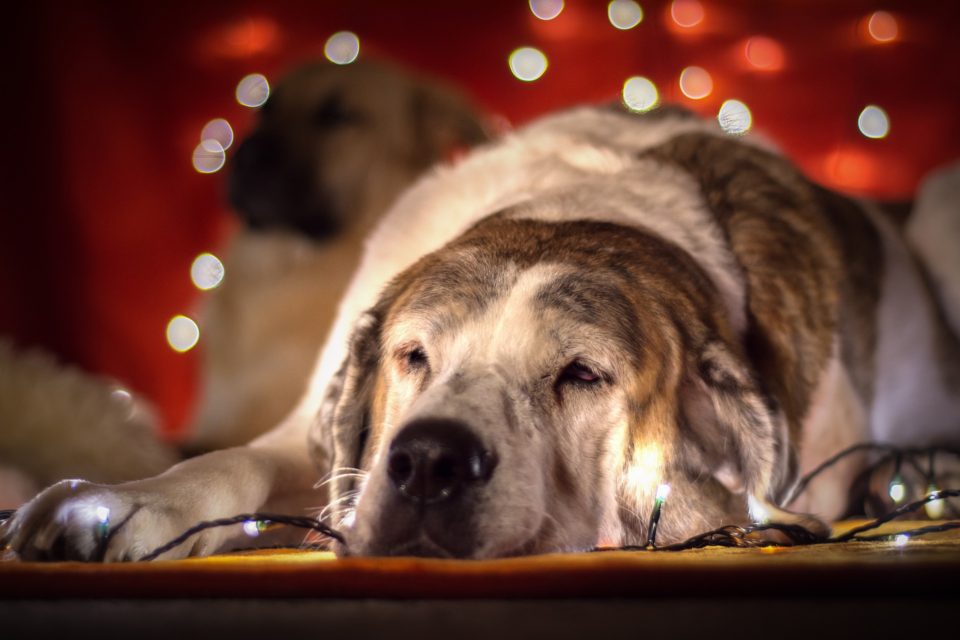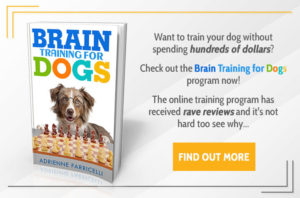Welcome to your complete overview of the Christmas dangers for dogs!
My name’s Caitlin and I’m the proud mum to my adorable Jack Russell called Harvey.
However, it’s that time of year again. In theory, Christmas is sorted, the presents wrapped, cards sent off, decorations up and twinkling and family all cuddled in the sofa watching Elf. Perfect
Time for a reality check… you lost half the Christmas presents in your ‘safe place’, the cards are still in the box, better luck next year. You got pressured into inviting both grandparents but grandma and grandpa are in an argument and aunt Betty won’t talk to cousin Nigel and it’s all a bit of a mess but its family right?
Last thing you need is a medical emergency with your favourite, furry family member.
It won’t happen to you? Vets Now, a UK out of hours specialist veterinary company see a 40 % increase in emergency calls at Christmas. Your local practice may not offer out of hours services, especially at Christmas and these services are extremely expensive with just the out of hours fee being over £100 and that’s before consultations.
Don’t add to that Christmas debt for something avoidable!
Therefore, I will share with you some of my personal stories where I learnt the harder way so you don’t have to go through the same stresses. Thankfully all my pets have been OK but it could have been a different story. I am not a vet but want to help people avoid any mishaps this Christmas.
What are the Christmas dangers for your dog? Some of the dangers can be split into a couple of categories; food, decorations and plants.
So, let’s not waste time and get straight into it below!
Poisonous Foods for Dogs
Although I’ve put together this guide for Christmas dangers, there is no harm in recapping this list, whatever the time of year
If you’re looking for some safe, edible gifts for your dog, you can check out our article on the best dog treats for Christmas here!

However, make sure to read the list below, so you know what NOT to give your dog!
1) Chocolate
Most dog owners know that chocolate is a no good for dogs, yet the festive period brings a 309% increase in chocolate poisoning cases in some vet practices.
It contains theobromine, a chemical stimulant similar to caffeine that we as humans can metabolise but dogs (and cats) can’t process as efficiently which means it can build up and potentially lead to a… fatality.
It affects the heart, central nervous system and kidneys causing seizures, but most likely in smaller amounts will just cause a stomach upset between four and 24 hours after eating it.
You should NEVER give your dog any chocolate deliberately (or at all really), but what about that bar you left on the coffee table or presents under the tree? Do not risk your dog getting anywhere near chocolate.
My dog once managed to squeeze herself through our stair gate; probably following our cats and helped herself to my Christmas present… thankfully it was only white chocolate and a little bit left of it. Chocolate doesn’t last in my household! It was horrifying to come home to the empty wrapper but she was ok.
Do not leave chocolate within climbing reach or even kitchen counters as larger dogs can jump up and snatch it off.
If your dog does get hold of some chocolate, how bad is it? Well veterinary practices work on 100mg per kg of bodyweight being a fatal dose but 20 mg is enough to cause symptoms. For example, a 30kg Labrador, 3000mg of theobromine could be fatal and it is even less for smaller dogs.
This can be less than a bar of chocolate but it all depends on the type of chocolate you have. Dark, good quality chocolate contains more than milk chocolate and white chocolate contains hardly any, although still best not to give your dog any chocolate whatsoever.
What to do if your dog eats chocolate? Call you vet immediately. Save the wrapper of the chocolate too if you can as it will help your vet access the exact quantity of theobromine your dog may have ingested.
Remember there are plenty of safe, dog chocolate options available if you don’t want your pup to miss out. Just ensure you give them the correct one!
2) Caffeine
The effects are similar to that of chocolate poisoning. This is mainly going to be a concern if your dog gets hold of fancy coffee beans or tea bags in a new tea lover gift set.
The odd slurp of the dregs of your tea you left on the coffee table shouldn’t cause much concern just keep an eye on your pup.
3) Onions, garlic and chives
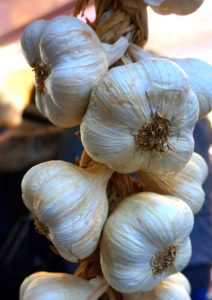 These are in nearly everything so make sure you check the ingredients before feeding your dog bits of your Christmas dinner! It is even in some baby food.
These are in nearly everything so make sure you check the ingredients before feeding your dog bits of your Christmas dinner! It is even in some baby food.
Onions are particularly problematic in any form; raw, cooked, dried it’s no good for your dog.
These contain a chemical called thiosulphate. This causes hemolytic anemia, this is where the red blood cells burst leading to lethargy, breathlessness and diarrhoea and vomiting but these symptoms may not appear for several days after you dog ate the problematic vegetable.
Issues can be seen from consuming as little of 0.5 % of your dog’s body weight at one time. Back to our 30kg Labrador example, this means that 0.15kg of onions.
4) Grapes and Raisins
Grapes are the perfect complement to your cheese board to impress the in-laws? MINCE PIES? CHRISTMAS CAKE? All a big no for your dog as they contain a range of raisins and currents. Keep them well away.
These innocent looking fruits can cause kidney failure but it is unknown what is causing the toxicity. This means that vets have to treat any ingestion as potentially fatal.
5) Alcohol
Alcohol is a poison to human and dogs alike. It affects dogs in much the same way but remembers that most dogs are smaller than you and therefore will be a ‘lightweight’.
Christmas day, the only day of the year where the average time for the first drink is 9:05am!
My family no exception, we have a tradition to drink at 11am to honour those who cannot be with us on Christmas day, but my dogs will be sticking to water.
6) Macadamia Nuts
Nuts around the fireplace at Christmas?
Eating these nuts when treated tends to not be fatal but do cause vomiting, muscle tremors but this do need to be treated with intravenous fluids at the vets so best to avoid any mishaps.
Once again, it is unknown why these are poisonous and its only dogs which appear to be affects.
7) Cooked Bones
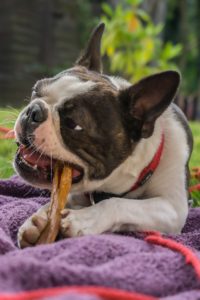 Dogs love a good bone right? They definitely do but do not give your dog the leftover Christmas turkey skeleton.
Dogs love a good bone right? They definitely do but do not give your dog the leftover Christmas turkey skeleton.
Cooked bones can easily splinter which can cause cuts in the mouth or perforation of the gut which can be fatal. In large quantities they can also cause constipation.
Most raw bones are considered safe treat with some being considered nutritional but its best to double check before you treat your pup to a treat this Christmas.
8) Corn on the Cob
Common with the Christmas dinner and corn itself is perfectly safe and nutritional for your dog if you want to give them a Christmas dinner of their own.
The problem is the cob, as it can get stuck in your dog’s intestine so make sure you remove any corn first.
9) Artificial Sweeteners
Xylitol is found in a lot of sweets, which obviously we consume a lot more at Christmas.
It’s also in chewing gum so just bare in mind before your mistletoe kiss that your chewing gum is safely hidden.
The chemical causes your dogs body to release insulin causing low blood sugar, resulting in vomiting, lethargy, convulsions and comas and can also damage the liver.
10) Blue Cheese and Other “Fancy” Cheeses
The mould that gives these cheeses their unique taste and appearance produce a compound called roquefortine C which in some dogs can cause diarrhoea and vomiting and a high temperature. You should also be aware of any cheeses with other ingredients such as dried fruits, onions or herbs as these can be toxic to your dog.
Cheeses are good as a treat in small amounts but remember that it is high in fat and salt and therefore don’t give your dog too much and it should be avoided for overweight dogs or dogs with upset tummies already or dogs which are lactose intolerant. Be aware that your dog shouldn’t join you with your festive cheese board.
11) Mouldy Foods
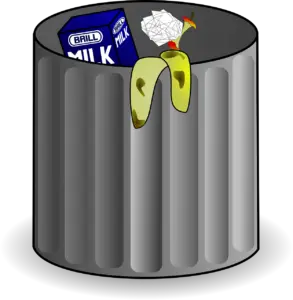 4.2 million Festive dinners are being thrown away during the Christmas period. That obviously is a complete waste but doesn’t hurt your dog.
4.2 million Festive dinners are being thrown away during the Christmas period. That obviously is a complete waste but doesn’t hurt your dog.
What does hurt your dog is when they get hold to that mouldy turkey in the bin that you haven’t got round to taking out yet because the bin men don’t come for another week?
Depending on the type of mouldy food there two types of toxins which can make your dog very sick. Firstly and most commonly is tremorgenic mycotoxins produced by the moulds growing on foods such as breads.
These toxins are identifiable through symptoms such as vomiting, tremors and panting.
Alternatively they could ingest aflatoxins which are produced by Aspergillus moulds which grown on plant based matters such as nuts. This toxin causes liver damage, so symptoms which may not appear for a few days afterwards which include vomiting and diarrhoea, thirst, lethargy and jaundice. These can both cause fatalities…
Make sure if you do have too much food this Christmas that it is disposed of appropriately and even the most determined dog cannot get to it, also be aware that bin bags on the garden waiting for collection may be torn apart by wild animals or you dog and either way end up with your dog eating some unwelcome snacks.
Overview of Foods
Hopefully your dog won’t get their teeth into anything poisonous this Christmas but just in case they do make a note of what you think they may have eaten as this will help the vet identify the cause of the problem. This is likely not a complete list and is no way better than your vets advice.
They even suggest to bring the wrapper if you can. Some reactions may occur several days after the incident so if you suspect anything then make a note.
I’m sure no one will mind you writing on the back of a Christmas card!
Dogs and Christmas Decorations
Now, since this article is focusing on the Christmas Dangers for your dog, I can’t leave this out!
Christmas is full of new and unusual things for a dog, mixed in with the excitement may even lead the most well behaved dog to chew or eat pretty much anything. We have just covered what foods, and now the second part of Christmas decorations. Namely focusing on the tree but whether they are in your house.
 I’m going to based this around the Christmas tree.
I’m going to based this around the Christmas tree.
First things first. The tree itself. The pine needles can cause upset tummies due to a low toxicity. Fake or real can also cause irritation to there feet and perforation of the gut if ingested.
I also have my tree tied to hooks in the wall just to make sure he can’t topple it over. I did learn the hard way and broke my angel tree topper!
Some dogs do have a sensitive stomach and it is probably best to tidy up and hoover the needles that do fall onto the floor.
Tinsel is not good for tug o’ war, sadly. It can cause blockages if you dog eats it. Furthermore, small baubles can be swallowed and larger ones chewed. Also glass ones are particularly problematic as they can shatter.
Basically keep your least dog-friendly and favourite baubles at the top of the tree out of the way from curious noses. Even well behaved dogs may start chewing at this festive time as its all changes and dogs explore, like children with their mouths.
A good excuse to hand make your snow globes. Some imported versions contain antifreeze, and a few tablespoons can be fatal. Water is safe, obviously chewing the plastics or glass isn’t but at least it won’t be poisonous if they do get their paws on it.
No tree would be complete without some fairly lights, but don’t come home to find that your dog has decided to chew through them. This is not something you want to learn the hard way. It is not worth the risk, it can electrocute them and can be fatal.
It can be a nightmare to keep lights and wires up out of reach, but a suggestion if you can’t do that is to tape the wire to the wall so its not dangling and a temptation.
A bare bottom half of the tree is definitely worth it, to keep your dog safe at Christmas.
Other Plants
Basically if you do not eat it yourself don’t give it to your dog, although check my list above to ensure its also not poisonous to your dog. Poinsettias, holly, mistletoe and pine sap are all poisonous to pets.
Cyclamen is highly toxic and can cause death if large amounts are swallowed so keep it out of reach of your pets.
The Dangers of Wrapping Paper
My dogs love nothing more than helping unwrap our presents. The paper is the best bit for them, apart from the Christmas turnkey perhaps. Dogs love joining in and on this occasion it will unlikely cause any harm if they are only shredding it to pieces. Your Hoover on the other hand may not thank you later!
Things to watch out for are the dye may cause staining of your dog’s mouth. This isn’t usually a problem as the inks used tend only be mildly toxic so it’s not much difference to you eating a blue slushy and your tongue turning blue, however, if your dog swallows a large amount it can cause a stomach obstruction.
Final Thoughts…
 Hopefully, everyone will have an amazing time this Christmas.
Hopefully, everyone will have an amazing time this Christmas.
Just be aware that many dogs will enjoy all the attention, others may get a bit spooked so ensure there is a nice, quiet space for your dog to keep them calm whether they are over excited or stressed.
My top tips to you are:
1) Check the ingredients, if any of it contains any of the foods listed above then it’s a no go!
2) Assume everything near the floor is within chewing distance. Find a safe place, away from your dog for all your potentially harmful presents or all presents if you don’t know what’s in them!
Your dog getting hold of your fancy chocolates is a completely different storey to chewing your favourite slippers. Santa can always bring you some more slippers!
3) Tell your friends that you are not putting presents under the tree. That way they won’t have to give any hints away if you’re present is anything harmful and no one will get offended if you don’t put the present under the tree.
4) There are many safe presents for dogs. Buy a new chew or a collar so they can join in all the fun
Thanks for reading, if you have any comments or questions, please leave them below!
